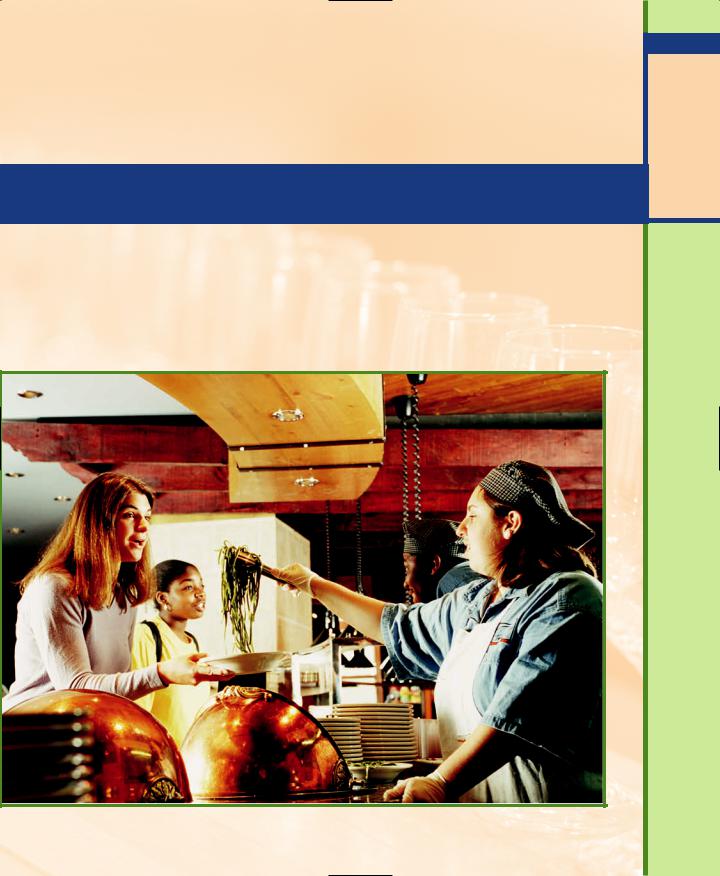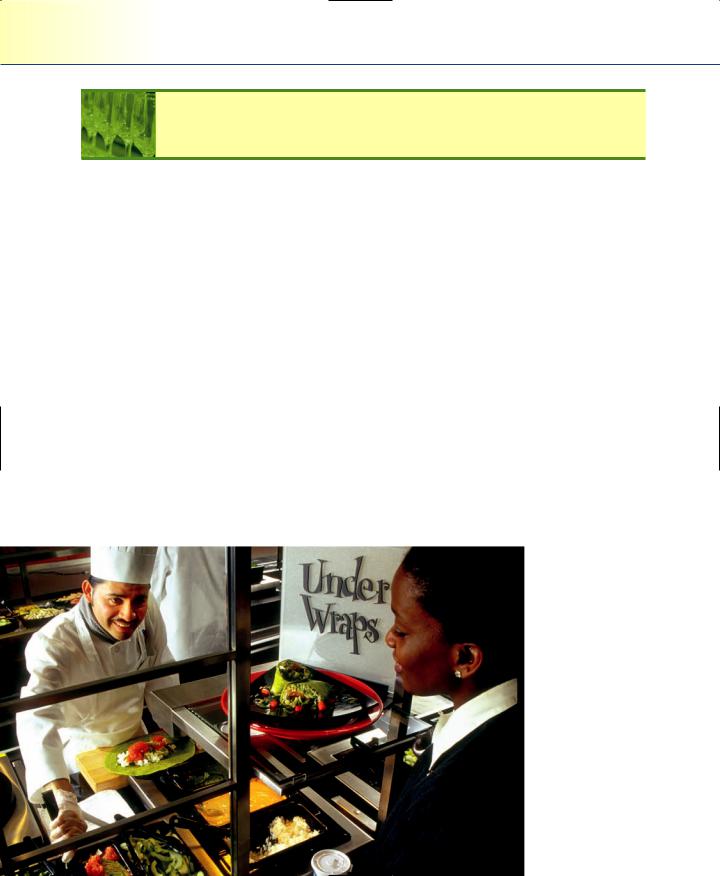
- •CONTENTS
- •PREFACE
- •Content—Benefits for Students
- •Content—Benefits for Instructors
- •Features of the Book for Students and Instructors
- •Supplementary Materials
- •Acknowledgments
- •What Is Hospitality Management?
- •The Manager’s Role in the Hospitality Industry
- •Why Study in a Hospitality Management Program?
- •Planning a Career
- •Employment as an Important Part of Your Education
- •Getting a Job
- •Employment at Graduation
- •The Outlook for Hospitality
- •Summary
- •Managing Change
- •Demand
- •Supply
- •Workforce Diversity
- •The Impact of Labor Scarcity
- •Summary
- •The Varied Field of Food Service
- •The Restaurant Business
- •The Dining Market and the Eating Market
- •Contemporary Popular-Priced Restaurants
- •Restaurants as Part of a Larger Business
- •Summary
- •Restaurant Operations
- •Making a Profit in Food Service Operations
- •Life in the Restaurant Business
- •Summary
- •Chain Restaurant Systems
- •Independent Restaurants
- •Franchised Restaurants
- •Summary
- •Competitive Conditions in Food Service
- •The Marketing Mix
- •Competition with Other Industries
- •Summary
- •Self-Operated Facilities
- •Managed-Services Companies
- •Business and Industry Food Service
- •College and University Food Service
- •Health Care Food Service
- •School and Community Food Service
- •Other Segments
- •Vending
- •Summary
- •Consumer Concerns
- •Food Service and the Environment
- •Technology
- •Summary
- •The Evolution of Lodging
- •Classifications of Hotel Properties
- •Types of Travelers
- •Anticipating Guest Needs in Providing Hospitality Service
- •Service, Service, Service
- •Summary
- •Major Functional Departments
- •The Rooms Side of the House
- •Hotel Food and Beverage Operations
- •Staff and Support Departments
- •Income and Expense Patterns and Control
- •Entry Ports and Careers
- •Summary
- •The Economics of the Hotel Business
- •Dimensions of the Hotel Investment Decision
- •Summary
- •The Conditions of Competition
- •The Marketing Mix in Lodging
- •Product in a Segmented Market
- •Price and Pricing Tactics
- •Place—and Places
- •Promotion: Marketing Communication
- •Summary
- •The Importance of Tourism
- •Travel Trends
- •The Economic Significance of Tourism
- •The United States as an International Tourist Attraction
- •Businesses Serving the Traveler
- •Noneconomic Effects of Tourism
- •Summary
- •Motives and Destinations
- •Mass-Market Tourism
- •Planned Play Environments
- •Casinos and Gaming
- •Urban Entertainment Centers
- •Temporary Attractions: Fairs and Festivals
- •Natural Environments
- •On a Lighter Note. . .
- •Summary
- •Management and Supervision
- •The Economizing Society
- •The Managerial Revolution
- •Management: A Dynamic Force in a Changing Industry
- •What Is Management?
- •Summary
- •Why Study Planning?
- •Planning in Organizations
- •Goal Setting
- •Planning in Operations
- •The Individual Worker as Planner
- •Long-Range Planning Tools
- •Summary
- •Authority: The Cement of Organizations
- •Departmentalization
- •Line and Staff
- •Issues in Organizing
- •Summary
- •Issues in Human-Resources Management
- •Fitting People to Jobs
- •Recruiting
- •Selection and Employment
- •Training
- •Retaining Employees
- •Staff Planning
- •Summary
- •The Importance of Control
- •Control and the “Cybernetic Loop”
- •Tools for Control
- •Summary
- •Leadership as Viewed by Social Scientists
- •Why People Follow
- •Leadership Theories
- •Communication
- •The Elements of Leading and Directing
- •Developing Your Own Leadership Style
- •Summary
- •A Study of Service
- •Rendering Personal Service
- •Managing the Service Transaction
- •How Companies Organize for Service
- •Summary
- •INDEX

182Chapter 6 Competitive Forces in Food Service
home life is of the utmost importance to them. Thus, in a way, the home can be considered a form of competition.
The number of meals purchased at restaurants is growing, according to a leading market researcher, but an increasing proportion of these meals are takeout. Indeed, the home is emerging as an entertainment center. Television watching and Internet surfing are two of the top leisure activities. A substantial majority of people own a DVD and make significant use of them while the number of computer owners continues to increase. Americans spend a good portion of their free time watching television (30 percent by one account), and television options have exploded, as anyone with cable, satellite, or digital capabilities can attest. This has only contributed to the ease with which Americans can spend their free time in their homes.
The home computer’s capabilities are being expanded by manufacturers. Online computer services such as Prodigy and CompuServe offer functional services such as stock market news and the ability to book your own travel reservations. These services also provide a variety of chat rooms and other entertainment options.
The home is, increasingly, becoming a control point for consumers—it is an environment that maximizes consumers’ control over factors that impact their lives. It is their territory. The pattern of activity that emerges suits itself well to staying home with somebody’s take-out meal. It is not surprising that plenty of competitors exist for that business. The growth in takeout and delivery is clearly the restaurant business’s response to this freezer case competition.
The future probably offers only more encouragement for “cocooning,” the term coined by Faith Popcorn to describe the practice of staying at home, as computers continue to play an even more important role in our lives than they did a mere few years ago.
Summary
It should be clear at this point that the food service landscape is changing and that the competitive environment is as well. In competitive terms, food service chains are operating in a mature market characterized by established operations with sophisticated marketing and proven operating formats. Successful independents compete by differentiation or by dominating small specialized markets. In spite of increasing chain market share, the food service market remains a highly competitive one characterized
by many buyers and many sellers.

Summary 183
We used the marketing mix to characterize competitive activity in food service. As product is essentially the guest’s experience, all the elements of the operation are important. Food quality is absolutely essential, and new food products are a major way of stimulating guest interest and renewing an operation. The product life cycle concept means not that established products or concepts die out but rather that concepts need to be reinvigorated.
Price has been used as a lead variable in the marketing mix, but competitive prices develop eventually. Consequently, long-term competition is usually focused on nonprice variables. Temporary price cutting, as with coupons, can be effective in the short run, particularly in the off season. Although price reductions risk cheapening the product in the guests’ eyes, sometimes market conditions dictate a long-term reduction in price levels, as in the case of fine dining at the end of the 1980s, when guests’ perceptions of value changed.
Place denotes two somewhat different ideas. Place as location involves factors such as traffic, population density, and proximity to major attractions. On the other hand, the notion of places refers to distribution and intercept marketing. This involves having operations, sometimes downscaled PODs, available wherever customers choose to go in large numbers.
Promotion is a critical element in the food service marketing mix. Food service is one of the largest advertisers in North America, and advertising is often built around themes that are used in several ads or commercials. We discussed the increasing role that the Internet is playing. Sales promotion is used to stimulate immediate purchase. Some of its principal tools, usually called deals, are coupons, games, and promotional merchandise. In upscale operations, sales promotion often takes the form of special events. A highly targeted form of sales promotion is aimed at a company’s present customers in frequent-guest programs.
Food service must compete with all other consumer products and services but faces particular competitive challenges from C-stores, supermarkets, and the comforts and conveniences of home.
Key Words and Concepts
Marketing mix |
New Products |
Product |
Life cycle |
Price |
Concept extension |
Place |
Branding |
Promotion |
Value pricing |

184 |
Chapter 6 Competitive Forces in Food Service |
Couponing |
Advertising |
Location |
Sales promotion |
Distribution |
Competition with all |
Points of distribution |
other industries |
(PODs) |
|
Review Questions
1.How has the competitive climate in which the food service industry operates changed over the 20 years?
2.What is the role of new products in a competitive strategy?
3.What are the stages of the restaurant life cycle?
4.What are the benefits and risks of value pricing?
5.How is the concept of distribution being used in food service competition?
6.How is the Internet being used in food service competition? What new developments do you anticipate in the use of the Internet in food service competition?
7.When is sales promotion used? What are its principal elements?
8.Discuss the significance of each element of the marketing mix in food service competition in your city. What recent developments strike you as significant in the local competitive scene?
9.What competitive practices have grocery chains in your area engaged in that will affect food service? How do you rate local C-store competition against quick-serv- ice restaurants?
Internet Exercises
1.Site name: Buca di Beppo
URL: www.bucadibeppo.com
Background information: Buca di Beppo is a neighborhood restaurant where guests
feast on family platters of real, immigrant, Southern Italian specialties in a boisterous, celebratory environment that recalls the Italian-American supper clubs of the 1940s and 1950s. In immigrant fashion, they serve their food family-style, in portions meant for sharing.
Chili’s
URL: www.chilis.com

Summary 185
Background information: Chili’s offers a distinct, fresh, healthy mix of grilled American favorites prepared in a way that keeps guests coming back. Chili’s is part of a family of restaurants operated by Brinker International.
Site name: Smokey Bones
URL: www.smokeybones.com
Background information: Smokey Bones BBQ is a casual dining restaurant that combines great-tasting, authentic American barbecue with a rustic, mountain lodge decor. Smokey Bones is part of a family of restaurants operated by Darden Restaurants.
Site name: Outback Steakhouse
URL: www.outback.com
Background information: Outback offers high-quality food and service, generous portions at moderate prices, and a casual atmosphere suggestive of the Australian Outback. Although beef and steak items make up a portion of the menu, Outback also offers a variety of chicken, ribs, seafood, and pasta dishes.
Exercises:
a.What characterizes a good restaurant Web site from a marketing standpoint? What elements should be present on a Web site to make it an effective marketing tool?
b.Which of the above Web sites do you believe presents the best marketing effort? Why?
c.Which of the above restaurants advertises promotional merchandise on their Web site? How effective do you believe promotional merchandise is in attracting customers?
d.Overall, discuss how effective you believe Internet Web sites are in marketing a restaurant concept. Why?
2.Site name: Convenience Store Decisions
URL: www.csdecisions.com/
Background information: Convenience Store Decisions is the in-print “Idea Factory”
for the convenience store industry. Written for and read by the industry’s decisionmakers, the monthly magazine has a qualified circulation of more than 40,000 subscribers and offers award-winning, compelling editorials and consistent coverage of current issues of real concern to convenience store operators.
Site name: The National Association of Convenience Stores
URL: www.nacsonline.com/
Background information: The National Association of Convenience Stores (NACS) is an international trade association representing more than 2,200 retail and 1,800

186 |
Chapter 6 Competitive Forces in Food Service |
supplier company members. NACS member companies do business in nearly 40 countries around the world.
Site name: Convenience Store News —Food Service Section
URL: www.csnews.com/csn/foodservice/index.jsp
Background information: Convenience Store News’ mission is to deliver the insight, analysis, market research, and business intelligence that helps C-store retailers stay ahead of what’s next. –The e-publication provides critical information to grow sales and profits.
Exercises:
a.Review the above Web sites to determine the food service products and services provided by convenience stores. What type of food service products are typically sold in convenience stores? What are the emerging products that convenience stores are migrating toward in the future?
b.Who is the target market for convenience-store food services?
c.Which restaurant sectors do the convenience stores compete against and what strategies should that restaurant sector utilize to maintain their customer base?
d.What potential job opportunities might be available for hospitality management students in the convenience store industry?
Notes
1.Robert Lewis and Richard Chambers (2000). Marketing Leadership in Hospitality, Hoboken, NJ: John Wiley & Sons.
2.The marketing mix is a convenient frame of reference for discussing current competitive practices. Some would argue, however, for other, different definitions, and in fact, the definition we employ evolves from a simple four-Ps approach to something a bit more complicated.
3.Deborah Silver, “Life in the Fast Lane,” Restaurants and Institutions, February 15, 2001.
4.Deborah Silver, “Small Change,” Restaurants and Institutions, August 15, 2000.
5.Another form of marketing communication, which is not discussed here, is public relations. This is particularly important to upscale operations.
6.2004 Restaurant Industry Operations Report (Washington, D.C.: National Restaurant Association, 2005).
7.Standard and Poor’s Net Advantage, 2006.
8.McDonald’s Press Release, September 2, 2003, Munich Germany.
9.Rebecca Gardyn and John Fetto, “Race, Ethnicity and the Way We Shop.” American Demographics, February, 2003.
10.“Restaurant Operator Technology Survey,” National Restaurant Association, 2001.
11.Reid Paul, “The Online Experience,” Hospitality Technology, July/August 2006.

Summary 187
12.Cihan Cobanoglu, “The New Service Frontier: The State of the Online Restaurant Industry,” Hospitality Technology, July/August 2006.
13.R&I Insider, Restaurants and Institutions, April 1, 2005.
14.Correspondence with National Association of Convenience Stores, (www.NACSonline. com), November 14, 2006.
15.Steve Adams, “A Market Heats Up,” The Patriot Ledger, June 30, 2006.

The Hospitality Industry
(Courtesy of Sodexho.)

CCHHAAPPTTE ERRSOEVNEEN
On-TheSiteHFospitalityodService
Industry and You
The Purpose of this Chapter
his chapter discusses the important and significant segments of the food service industry that
Tmake up the on-site segment. Some of the characteristics of this component of the hospitality industry are unique. Yet the increasing emphasis on marketing and use of brand names in the on-site sector would suggest that the lines between on-site food service and so-called commercial segments are becoming increasingly blurred. The on-site segment (including both contracted and selfoperated units) offers excellent compensation, good opportunities for advancement, and often more stable working hours. Because many companies operate in both the commercial hospitality industry and the on-site sector, it is an area that you may come into contact with even if your plans now are to work in hotels or restaurants. It is, in short, an area of the industry that deserves careful examination
and more attention than it normally receives.
THIS CHAPTER SHOULD HELP YOU
1.Describe the four major segments of on-site food service operations and the employment opportunities each offers.
2.List the differences between self-operated food service facilities and those operated by managed-services companies.
3.Explain the distinction between client and guest in the on-site food service environment.
4.Describe the four basic models under which many retirement housing communities operate.
5.Describe the recreation and transportation segments of the on-site market.
6.Identify the role that private clubs play in the industry, and identify the types of career opportunities they provide.
7.List the advantages that vending offers in meeting guest and client needs.
8.Identify elements common to the different lines of business in the on-site sector.

190 |
Chapter 7 On-Site Food Service |
Comparing On-Site and Commercial
Food Services
Any discussion of the on-site sector, to those more familiar with traditional restaurants, requires that one expand his or her preconceptions of what the food service industry encompasses. Even the terminology used to describe this segment tends
to be different. For instance, there are several terms used to describe this segment— on-site being one of the more current terms in use (although one still hears the terms institutional and noncommercial, too). Also, the sector is so broad and encompasses so many different types of operations that to attempt to group all of these different businesses under one umbrella does the sector a bit of an injustice. This will become clear as the different subsegments are discussed.
Another reason that discussions of this segment require looking beyond the traditional restaurant model is because of the different types of companies that operate within the segment. For instance, an important distinction within on-site food service is between managed-services companies that manage a food service facility for a third party and organizations that operate their own food service (hereafter, self-ops).
Finally, dividing the larger food service industry into commercial and on-site segments is somewhat artificial and misleading, as some of the same firms that profit from providing institutions with food service also operate in other areas of the hospitality industry. ARAMARK, for instance, also operates hotels in national parks and has a line of business that supplies uniforms. Sodexho USA is a member of the Sodexho Alliance.
On-site food service operators can plan the number of meals to serve with more certainty than can commercial restaurants. (Courtesy of Sodexho.)

Comparing On-Site and Commercial Food Services |
191 |
Sodexho operates ships providing river and harbor cruises throughout North America and Europe. Compass Group, until recently, owned several hotel chains and is also involved with facilities management in the health care sector. As one quickly discovers, there are numerous companies that operate in sometimes completely different hospitality environments simultaneously, as evidenced by the preceding examples.
Returning our focus specifically to the on-site food service sector, we should first attempt to define it. Simply, it consists of all locations where food is served outside of the home but where food service is not the primary business, such as universities or sports arenas. This definition obviously includes a significant number of locations, and indeed, the sector is quite large and varied. This will become clear as we delve further into on-site food service. One way to articulate what this segment is all about is to make comparisons with the more visible restaurant industry.
There are significant differences that exist between restaurants and on-site food service, and students should be aware of these. One important difference is that whereas on-site food service once represented a “captive market,” restaurant customers have always had a range of choices, including choices of facilities and menus. This distinction still exists, but to a much lesser extent. On-site food service providers, both selfoperated and managed, have found that, with certain exceptions, guests do have a choice in the long run. As a result, food service operators have found that a marketing approach that views patients, company employees, and students as guests and focuses on their preferences is an approach that tends to win more friends than the old eat-it-and-like-it institutional attitude.
Success is also measured a bit differently, by the participation rate of the guests. University students who don’t like the food withdraw or cut back on board plans; patients who have a choice of hospitals often choose the institution with superior food service; and even prison inmates find ways to assert their food preferences. In an age of consumerism, moreover, even guests who can’t “vote with their feet” and go someplace else don’t hesitate to complain. Therefore, competition among the various food service contractors is often decided on the basis of marketing techniques as well as management skills.
Another major difference between traditional restaurants and on-site services relates to their primary functions. Even though many companies provide both restaurant and on-site food services and use similar marketing and managerial techniques in both areas, the major difference between the two markets is that the food service in institutions is a small part of a larger operation with a greater purpose of overriding importance— health care (hospitals, nursing homes, etc.), education (K-12 and universities), or businesses (services and manufacturing), for instance. In a commercial restaurant, the challenge is to please the guest. In the on-site environment, it is necessary to meet the needs of both the guests and the client (i.e., the institution itself).

192 |
Chapter 7 On-Site Food Service |
The distinction between client and guest is important. The client is the institution (bank, university, etc.) along with its managers and policy makers. These are the people who ultimately award the contract or, when the institution operates its own food service, hire and fire the food service director. Pleasing the guest (i.e., the individual diner, patient, student, or resident) is important, but the client must be pleased as well. The evidence suggests that the food service operator must do what is necessary to keep the client happy. Sometimes this isn’t so easy. There may be a substantial difference in an institutional setting between the needs and wants of the guests and those of the client. In school food service, for instance, the client’s (i.e., the school’s) goal is to provide not only adequate meals but also nutrition education by showing the students what a nutritionally balanced meal is like. The goals of a young schoolchild may obviously be quite a bit different.
If the food service is operated by a managed services company, the two parties must agree upon the type of contract to be followed as well as negotiate the terms of that particular contract. Contracts can take a variety of forms. Contracts sometimes call for the institution to essentially allow the contractor to operate on a break-even basis and to pay the contractor a fee every period for the management of the operation. Other contracts allow the contractor to operate solely on a profit-and-loss basis, where the contractor covers its own expenses and manages the revenues, taking sole responsibility for the profit (or loss) at the end of each period. Other contracts might be a hybrid of these two, depending on the scope of the operation. However, in most segments, the movement seems to be more toward profit-and-loss-type contracts. Whether the operation is subsidized, break-even, or for-profit, however, there is always some budgeted performance target that must be met regardless of who operates the service. Even for self-operated institutions, the trend is for them to become more self-sufficient, with a greater degree of fiscal responsibility.
Finally, the two segments (commercial and on-site) have very different operating challenges. For example, the number of meals and portion sizes are much easier to predict in on-site operations. Because of this greater predictability, these food service operations often operate in a less hurried atmosphere than that in restaurants, in which customer volume and menu popularity often fluctuate (it should be noted that this is not as true as it once was, though, as many operations move more towards a retail model).
Moreover, although managers tend to work long hours in commercial food service, the working hours in on-site food service are usually shorter, or at least more predictable. This is particularly true in environments that have discrete operating periods such as colleges and universities, and most businesses.
On the other hand, although a guest may visit a restaurant frequently, few of them eat as regularly in their favorite restaurant as do the guests in on-site operations. Thus,
